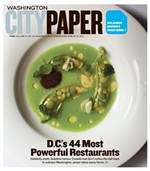The Ice Storm
Joseph Conrad’s fiction has often been adapted to film, although never as explosively as in Apocalypse Now, Francis Coppola’s sprawling improvisation on Heart of Darkness. Now that film has competition, although of a much chillier, more controlled sort. Running 90 minutes, and transpiring over a little more than a week, Patrice Chéreau’s Gabrielle (from Conrad’s “The Return”) is a highly stylized miniature set in an impeccably appointed Belle Epoque Paris household. The museumlike setting is meticulous, but that just heightens the terrible upset that is about to occur.
This emotionally frigid, stylistically thrilling drama opens with the sound of a train, and the first few shots are in black and white, suggesting a film the Lumière Brothers could have made, if only they’d had sound, Steadicams, and crisper lenses. (The cinematography is by Eric Gautier, who also shot Chéreau’s kinetic Those Who Love Me Can Take the Train.) Jean Hervey (Pascal Greggory) strides from the train station to his home, reflecting in voice-over on his excellent life and estimable wife, Gabrielle (Isabelle Huppert). “I’m proud of what she is: impassive,” he boasts to himself.
It’s Thursday, the night the Herveys always entertain. At dinner, the images turn to full color as one guest complains about the sensationalism of contemporary plays—perhaps a small joke on Chéreau’s career, which has been more in theater than cinema, but also a glancing reference to Jean’s preferred lifestyle. He wants things quiet, respectable, and unemotional. Or so he imagines until a few days later, when he finds a letter from Gabrielle. She is in love with another man and has left him.
This development does not open up the claustrophobic narrative, because Gabrielle soon returns. The letter was, she says, “a mistake.” What happened must be forgotten, Jean announces, and yet he can’t do that. The couple continues to discuss Gabrielle’s now-annulled affair and its implications as the next Thursday soiree approaches. At the party, unruly emotions come to the surface, and the guests leave early. The next morning, a startling epiphany leads to an unexpected resolution. Unexpected, that is, unless you’ve read Conrad’s story, whose final sentence flashes on the screen just before the credits roll.
Gabrielle is the third feature Chéreau has co-written with Anne-Louise Trividic, and in some ways it inverts the first, Intimacy. That film, adapted from a Hanif Kureishi novel and story, was a sexually explicit account of an affair between two near-strangers. It could be argued that the buttoned-up Jean and Gabrielle are also strangers, at least sexually, but they know each other better than Intimacy’s lovers. Chéreau and Trividic take more liberties with Conrad than they did with Kureishi, and not just by transplanting “The Return” to Paris from London; they also justify changing the title by greatly amplifying Gabrielle’s role. In the original tale, the man’s wife doesn’t even have a name. The movie gives the two people equal footing, if not equal power. It turns the story from an interior character study into a spoken exchange—from literature into theater.
Gabrielle could indeed be a theater piece, with just three main speaking parts: Gabrielle, Jean, and Yvonne (Claudia Coli), the maid in whom Gabrielle unsympathetically confides. (While Gabrielle’s lover talks in the dinner party scenes, he remains essentially anonymous.) Yet Chéreau also plays with the conventions of cinema: He switches between color and black-and-white, has Gautier shoot the stately interiors in hand-held widescreen, deploys Fabio Vacchi’s overwrought music in outbursts that both accent and alienate emotion, and flashes titles on the screen, evoking silent films as well as such form-breaking modernists as Jean-Luc Godard. Whereas Intimacy had a near-improvisational naturalness, every moment of Gabrielle feels painstakingly manipulated. Even Huppert’s nude scene is more iconic than earthy.
Huppert was cast first, and the script, written with her in mind, could hardly better suit her blend of severity and vulnerability. While the scenario forces the actress into states of extreme psychological exposure, she always keeps the bearing that led Jean to suppose that Gabrielle was “impassive.” Yet if the film is a showcase for Huppert, Chéreau and Trividic ultimately revert to Conrad’s original subject, the deceived (and self-deceived) husband. Greggory ideally complements Huppert—they play a perfectly matched mismatched couple—but he can also guide his own character into emotional territory unimaginable from Jean’s smug early remarks. It turns out that the opening train footage was not just a historical aside, for the film is as concerned with escape as it is with imprisonment. Gabrielle is set entirely within a Paris neighborhood, but simply to walk out the Herveys’ door is to embark on an epic quest.

